Learning to ride a bike is one of the most memorable childhood experiences and is a skill that stays with us our whole lives. From taking those initial pedal stokes to mastering the bike and pushing your limits, cycling is a wonderful journey. While you can learn to ride at any age, the earlier you start the easier it is to progress.
Learning to ride a bike has never been easier as there are a wide range of kids' bikes to suit every child at every age. Choosing the right bike and setting it up correctly for your child can make all the difference to their cycling experience.
Which bike is best for my child?
The best kids’ bike is one that fits properly - a bike that is too big or too small will be hard to ride and may put your child off cycling. See our Kids' Size Guide for more info on kids’ bike sizing. While it may seem like a good idea to buy a bike that your child will ‘grow in to’, if it is too big it may discourage them from riding. Similarly, a heavy bike is hard to ride, especially for young children. Cheaper kids’ bikes tend to be very heavy and are best avoided if you want your child to get the most out of their early cycling years. A correctly sized lightweight bike will give your kids the best start on their cycling journey.
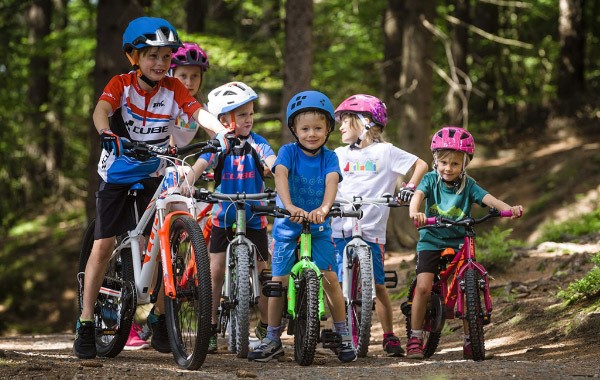
Balance bikes
Balance is the most important skill to master when learning to ride a bike. A balance bike is the simplest type of bike. With no pedals, gears or even brakes (on some models) to worry about, balancing skills are easily learned. Balance bikes generally have 10” or 12” wheels and are suitable for children aged one to four years. Some balance bikes have larger 14” wheels for children up to six years old. If your child is too tall or too old for a balance bike then you can turn a normal bike in to a balance bike by taking the pedals (or even the whole drivetrain) off.
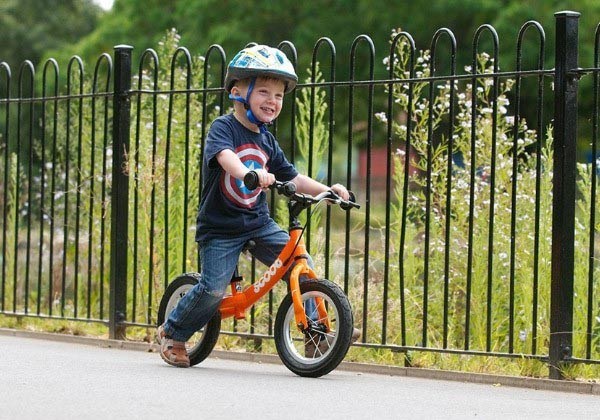
Popular Balance Bikes
Stabilizers
Many cycling instructors will advise you to avoid using stabilizers. There is good reason for this because, while stabilizers allow your child to learn how to pedal and brake, they make it harder for them to learn how to balance later on.
Pedal bikes
Once children have learned how to balance, the step up to a pedal bike is easy. As pedals allow them to go further and faster the first thing to learn is braking. Initially it’s a good ideal to stand in front of the bike, hold the handle bars and walk backwards, then get them to practice braking before they set off pedalling. We will look at how to set brakes up for little hands a little later.
To start kids pedalling, choose an open flat area that is clear all around. Some parents prefer a grassy field, for a softer landing if they fall, but grass is much harder to pedal on than tarmac, so they may find it harder to get going. Get your child to apply the brakes as they get on – this is good practice for all cyclists. Then, with one foot on the pedal they can release the brakes and push down on the pedal to get going. This will give them some momentum, so they can get the other foot on and pedal away. They may need a few attempts to get going but, if they have already mastered balance, then this step won’t take long.
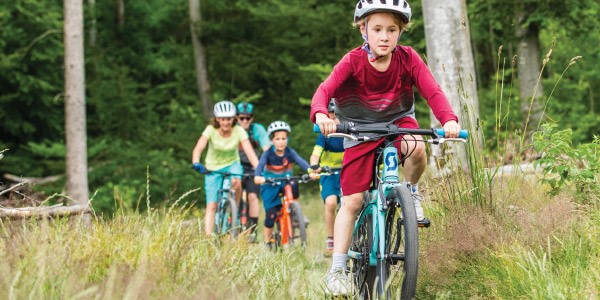
Most kids’ bikes follow a simple hardtail mountain bike design, with flat handlebars and high-volume tyres, as this is these are the easiest learn on. Kids bikes with 12” wheels, 14” wheels and 16” wheels are single speed, so they won’t need to worry about changing gear. You will find that some 18” wheel and most 20” wheel kids' bikes have a rear derailleur and offer a range of gears to help them up the hills.
Junior Bikes feature 24” wheels and are the step up to a full-size adult bike. Junior bikes are available in a range of styles, including drop bar race bikes and relaxed hybrid style bikes. Junior bikes are suitable for kids from the age of 10 and often feature both front and rear derailleur gears just like full-size bikes.
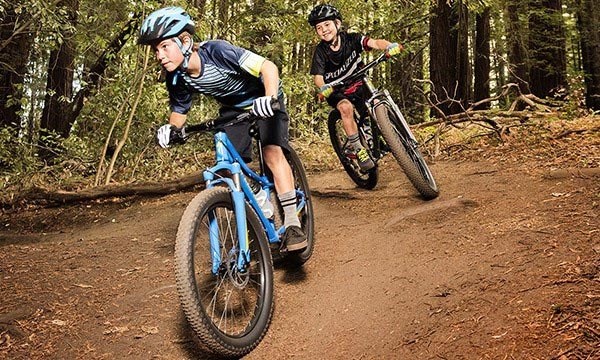
Popular Kids' & Junior Bikes
|
Kids Bike Sizing Chart |
||
|
Age |
Size |
Height (cm) |
|
1 - 4 |
Balance Bike |
77 – 105 |
|
2 - 4 |
12” |
85 – 105 |
|
4 - 6 |
14" |
105 – 117 |
|
5 - 7 |
16" |
112 – 125 |
|
6 - 8 |
18" |
117 – 132 |
|
7 - 10 |
20" |
125 – 136 |
|
10 + |
24" |
136+ |
The Golden Rule:
Choose a bike that fits
Avoid buying a bike which is too big for them with hopes they will 'grow into' the frame. It will be too heavy for them and difficult to ride.
You want them to easily reach the floor and pedals, and have full control of the handlebar and brakes.
There are some in between wheel sizes, take a look at our kids bike size guide for more.
Remember, you can always hand down bikes to younger siblings once they've outgrown their bike, or simply sell them on.
Who are junior bikes/ 24" Bikes for?
Junior bikes bridge the gap between kids bikes and adult bikes. With 24” wheels junior bikes are ideal for children who are over 135cm (4’ 4”) tall, which is usually around the age of ten years. Junior bikes are much like scaled down adult bikes with a wide range of gears and powerful brakes. Like adult bikes, junior bikes are available in different styles. Hardtail mountain bikes are most popular, but you can also get full-on road bikes with drop handlebars, relaxed hybrids with baskets on the front and even mini full suspension MTBs. Girls 24” bikes and 24” bikes for boys all feature 24 inch wheels. Some junior bikes, made for older kids and teenagers, have larger 26” wheels. We will look at these bikes a bit later.
Which is the best junior bike for my child?
The best junior bike for your child will depend on what type of cycling they like doing. Most kids at this age will not have settled on a specific cycling discipline, which is why hardtail junior mountain bikes are most popular as they offer all-round performance. Hardtail junior bikes, with flat handlebars, are a great choice for cycling around the local area on roads and cycle paths as well as off-road trails. These bikes are also ideal for Bike Ability cycle training as they are the easiest to ride. If your child is a keen mountain biker or roadie then a junior road bike or higher spec MTB will be a better choice.
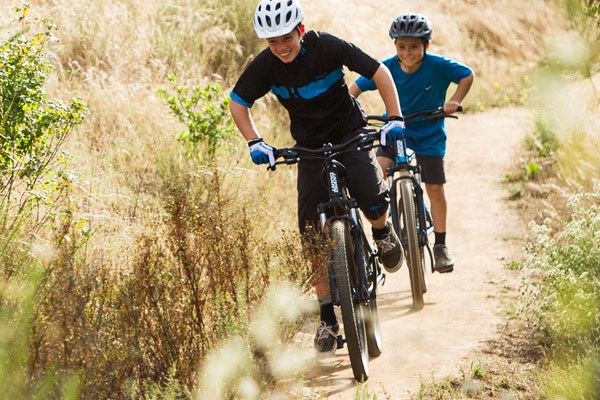
What are the things to look out for in a 24" junior bike?
Frame and Fork
The best junior bike frames are built from aluminium alloy. This material is lightweight and robust, making it perfect for all types of junior cycles. Steel frames are just as strong as alloy, but are significantly heavier making them harder for youngsters to ride. Rigid forks are best for road cycling with aluminium alloy forks being lighter weight than steel ones. Rigid forks are also good for light off-roading, but a suspension fork will give a smoother ride on rough surfaces. For proper off-road tracks a suspension fork is ideal.
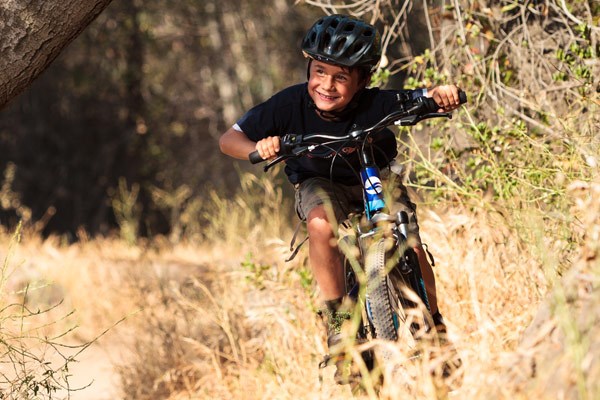
Wheels and tyres
While all junior bikes have 24 inch wheels, the tyres vary quite a lot and this makes a big difference to how the bikes ride. Generally speaking the narrower a tyre is the faster it will roll, and the wider a tyre is the more grip it will offer. This means that wider tyres are better for off-roading while narrower tyres are better for tarmac cycling.
|
Common Junior Tyre Sizing Chart |
|
|---|---|
|
Tyre Width |
Best For |
|
1.125” |
Rapid road cycling |
|
1.75” |
General road cycling |
|
1.95” |
Road and off-road cycling |
|
2.1” up |
Off-road trails and gravel tracks |
Gears
Most junior bikes feature derailleur gears to make cycling up and down hills easier. However more gears aren’t necessarily better. Bikes listed as having more than 10 gears usually feature double front chainrings, which many kids find difficult to manage. Single front chainrings with 6, 7, 8 or 9 speed cassettes are easier to use, especially on mountain and hybrid bikes, and still provide plenty of gear options for the climbs. Road bike style junior bikes usually have double chainrings like their adult counterparts. These bikes are ideal for keen young road cyclists who want the performance of an adult bike.
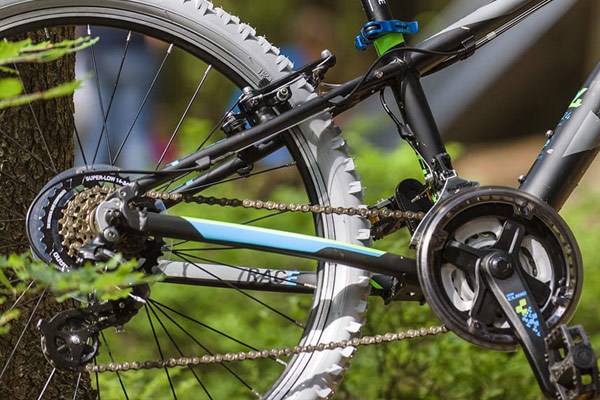
Brakes
Like adult bikes, there are two types of brakes on junior bikes. Rim brakes are the most affordable option and offer good stopping control, especially in dry weather conditions. Disc brakes are becoming more popular and offer a big advantage over rim brakes as they work equally well in both wet and dry conditions. Hydraulic disc brakes are the most powerful and are easiest to use.
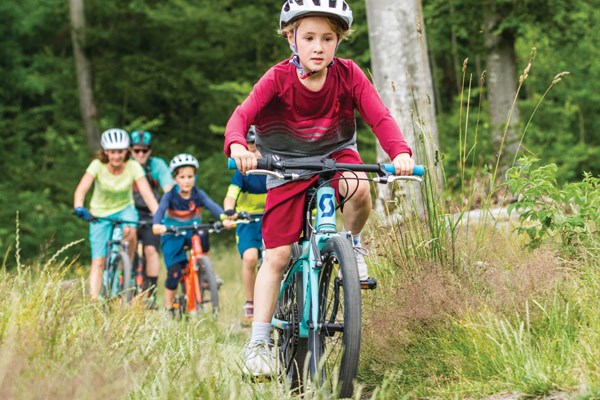
What about 26” junior bikes?
For slightly older, taller kids and teenagers, 26” wheel bikes are a great option. These bikes are much closer to full adult bikes with similar specifications. Hardtail mountain bikes with 26” wheels are most common, but you can also find a wide range of hybrid bikes with 26” wheels that are suitable for juniors. There are even a few road bikes with 26” wheels, these are a great choice for aspiring young road racers.
While some of these bikes are designed for junior riders and others for smaller adults, both will be suitable for girls and boys who are tall enough. See our bikes size guide to choose the right size 26” wheel bike for your child or teenager.
How to get the right fit
Choosing the right size bike for your child is easy. Kids bike sizes are based on wheel size. See our Kids Bike Size Guide for more info.
Saddle Height
Set the saddle height so that they can put both feet flat on the ground. This will give them the confidence to stop and start whenever they like and reduce the chances of them falling off. As they grow, move the saddle up to maintain the perfect fit. Once they have mastered the skills of balancing, pedalling, braking, and can steer their bike just where they want it to go, you can move the saddle up for a more efficient pedalling position.
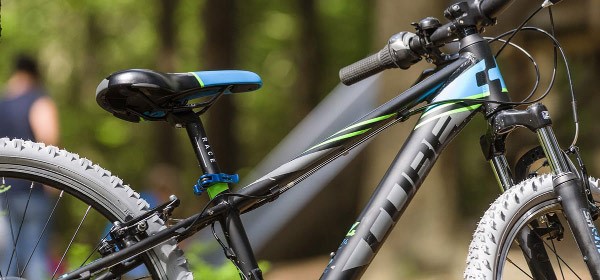
Brake Reach
It is important that your child can reach the brakes easily without having to stretch their hands or unhook their thumb from the handle bars. It is easy to adjust the reach of the brake levers and move them closer to the handlebars allowing them to brake easily. Most brake levers have a small screw that moves the brake lever closer to the bars, all you need is a small screwdriver or allen key to do this. Some premium kids’ bikes even have a tool free reach adjustment nob. You may need to adjust the brake cable tension with the barrel adjuster, as well as the reach to get the brakes working optimally for your child.
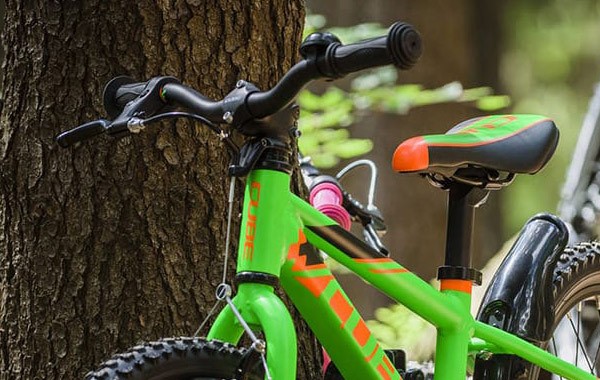
Handlebar Height
While this is less important than saddle height, you can also adjust the handlebar height on kids’ bikes. This is easily done be repositioning the spacers (on a A-headset) or by loosening the expander bolt and repositioning the stem before retightening (on a quill stem). Start with the stem in its lowest position then move it higher it as they grow to maintain the ideal riding position.
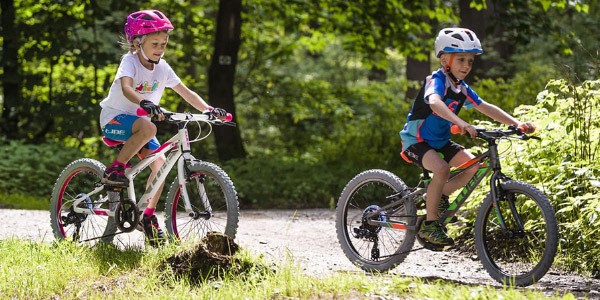
Bike Weight
After sizing, weight has the biggest impact on your child’s enjoyment while cycling. To understand why, remember that an adult bike can weigh around 20% of your body weight. Most kids' bikes can weigh up to a hefty 50% of their weight. Imagine strapping concrete blocks to your pedals and start riding, it wouldn’t be a nice experience. Generally speaking, the more you spend on a junior bike, the lighter it will be. This means the bike is easier to handle and manoeuvre, and that translates directly into fun and enjoyment.
Cycling with Children
The best way to get your kids into cycling is to ride with them as often as possible. Have a look at our guide to Cycling with Children for tips about riding with kids.




